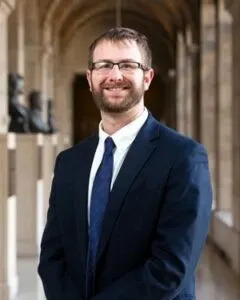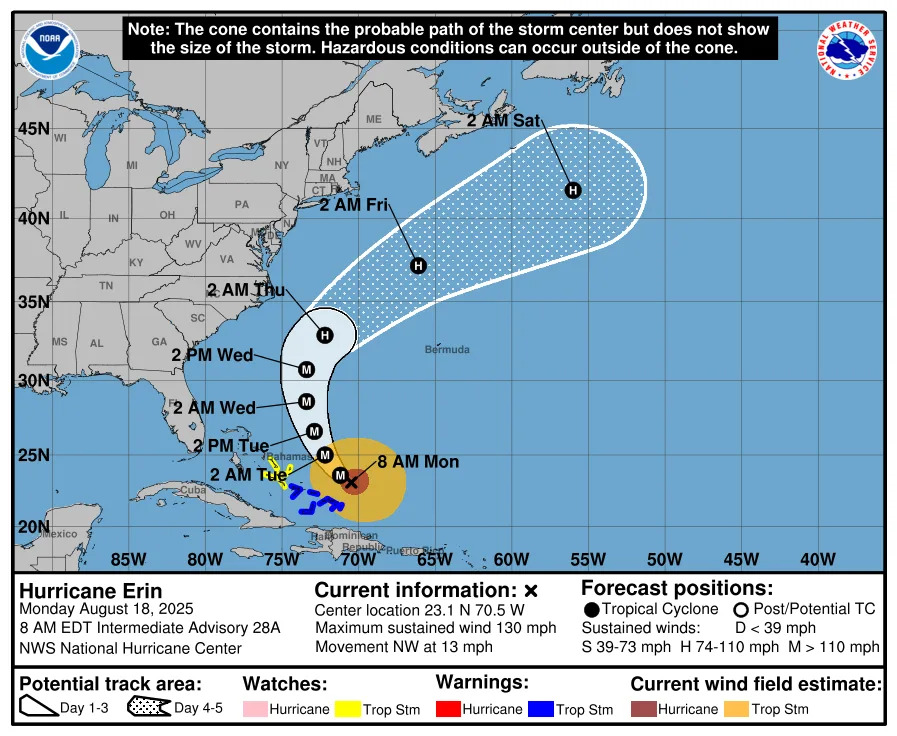
Nebraska Gov. Jim Pillen and State Sen. Rob Clements of Elmwood laugh after he signs a mock check signifying state investments in K-12 education. (Aaron Sanderford/Nebraska Examiner)
LINCOLN — A fund marketed as a sustainable source of state aid to Nebraska’s K-12 schools is on track to be completely depleted within five years of its creation.
The Education Future Fund (EFF) was designed in 2023 to lower property taxes while supporting school districts by providing resources that weren’t covered under Nebraska’s existing school funding formula. It launched with an initial investment of $1 billion and a commitment from state lawmakers to add another $250 million each year thereafter to keep it stable.
At the time, Gov. Jim Pillen said he hoped to build the fund to approximately $2.5 billion by 2029-30, but the state is spending money faster than it can grow. After that first $1 billion investment, expenses out of the fund have far exceeded revenue transfers into it by more than $150 million each year.
The Education Future Fund is now baked into Nebraska’s current school funding formula. Among other things, EFF offers per-pupil funding primarily to non-equalized school districts and assumes a higher level of state funding for special education.
Based on the fund’s projected ending balance in the state’s latest biennial budget and the trajectory of steadily increasing EFF expenses each year, if lawmakers only add the standard $250 million to the fund in fiscal year 2027-28, it will not have enough funds to cover its expenses by the end of that year, according to a Nebraska Examiner analysis.
This appears to be one of the worst-kept secrets among Nebraska state government and local education officials. Five school board members representing districts across the state told the Examiner that their boards had doubts about EFF’s lasting power when the fund was first introduced.
Barbara Baier, board member for Lincoln Public Schools, compared the state’s budgeting strategy of transferring revenues across different funds to “moving around deck chairs on the Titanic.”

Tim Royers, president of the Nebraska State Education Association, said lawmakers also know about this. When he approached Education Committee members in the Nebraska Legislature this session about adding resources to EFF, he said even his low-cost requests were rejected because lawmakers said there wasn’t enough money in the fund to support them.
Brad Wilkins, a board member for Ainsworth Community Schools, was on the task force that developed the idea for EFF. He said members of the governor’s staff claimed the fund would be sustainable for 10 years, but he said he questioned the estimate even then.
This touches on a longstanding lack of trust Nebraska’s education community has in the reliability of state government as a funding partner, Wilkins said. Lawmakers constantly ask school boards to lower their levy rates — and sometimes seek to cap them — while promising to take care of the districts if they comply, but they don’t always hold up their end of the bargain, Wilkins said.
“Some of those promises are hard to keep,” he said. “We need to keep this one.”
Despite the fiscal challenges, Pillen said he remains committed to ensuring the Education Future Fund remains alive. Lee Will, chief operating officer for Nebraska’s Department of Administrative Services, said the current plan is to increase the revenue transfers going into the fund.
“Fixing Nebraska’s property tax crisis while investing in our kids are my top goals as governor,” Pillen said in a statement. “We will ensure that the funding in the Education Future Fund is sustainable for generations to ensure we never give up on any kid in Nebraska.”
Where that additional revenue will come from, however, is a question that remains unanswered.
Foundation aid
The two biggest expenses out of the fund also come with the biggest statewide impacts: foundation aid and special education reimbursements.
Foundation aid was pitched as a way to support the vast majority of Nebraska’s 244 school districts that don’t receive equalization aid, what many know as state aid to K-12 schools. Foundation aid is a per-pupil funding mechanism that offers districts $1,500 for each student, minus any equalization aid the district already receives. Foundation aid costs roughly $112 million each year out of the fund.
Foundation aid’s impact largely depends on the district. At Lincoln Public Schools, Baier said they didn’t get much of a funding boost from foundation aid because the district already received a high amount of equalization aid.
But for smaller school districts like Ainsworth and West Point Public Schools, foundation aid makes a huge difference. Steven Blocher, board member at West Point, said the only state aid the district received prior to EFF’s implementation was allocated income taxes, which brought the district roughly $140,000 per year.
Foundation aid alone boosted West Point’s state aid by $1 million, Blocher said, and state special education reimbursements added another $360,000. He said the extra support helped the board approve an increase to teacher salaries.
In Ainsworth, Wilkins said foundation aid brought his district’s state aid from roughly $40,000 per year to about $450,000. He said that money was used nearly dollar-for-dollar to reduce the amount of property tax funds sought to operate their schools.
Special education reimbursements
Special education reimbursements make up an even larger chunk of the annual EFF payouts, ranging from $246 million in the fund’s first year to a projected $309 million in 2026-27. When the fund was created, lawmakers also approved increasing the state’s share of special ed costs covered from 40% to 80%. The program is largely split among federal and state funds, along with money from local school districts.
The demand for special ed services has been higher than both state and education officials expected, which is why the expenses have grown so much. Dave Welsch, board member for Milford Public Schools, said over the last decade his district’s special ed population has doubled.
Several other board members said their district’s special ed costs have increased much faster than they expected. This change is a factor in eroding the sustainability of the EFF in its current state, but it also brings the most consistent benefits from the fund to school districts, regardless of size.
Milford, for example, is “on the bubble” of Nebraska’s equalization formula, Welsch said, so the district can’t count on that support every year. But its reimbursements have raised the state aid the district receives by more than $600,000 each year.
LPS doesn’t receive much in foundation aid because of its equalization aid, but Baier said the special education funding has helped the district stabilize its budgets.
SUBSCRIBE: GET THE MORNING HEADLINES DELIVERED TO YOUR INBOX
Levies
A big purpose of the EFF was to encourage school boards to lower local property tax asking — the amount of money sought from local property taxpayers to fund schools — by providing the additional state support. That strategy appears to have worked, to some degree.
All five board members who spoke with the Examiner said their local levy rates had either dropped or remained level since the EFF was created.

Will noted that since 2023, school district property taxes have risen 1.7% year-over-year. He argued this is a sign that the fund is working, because city and county property taxes have risen 5.5% and 4.7%, respectively.
Steve Koch, board member for Hershey Public Schools, said EFF aid helped his board lower the local levy rate by more than 15%, reducing Hershey’s overall tax asking by roughly $400,000.
At West Point, Blocher said the board was able to lower the district’s levy from over 69 cents in 2022-23 to 57 cents in 2024-25.
Milford’s levy rate has been rising over time from 84 cents in 2019-20 to 93 cents in 2024-25, Welsch said. He argued that due to rising property valuations and the district’s equalization aid dropping, Milford’s levy growth likely would have been much higher without EFF support.
At Omaha Public Schools, the largest school district in Nebraska, the district’s allocation of state aid remained relatively unchanged in the first year EFF was implemented in 2023-24. The following year, however, state aid to OPS jumped from roughly $285 million to more than $316 million, according to documents a district spokesperson sent the Examiner to review.
Over the same period, OPS also lowered its total levy rate from $1.21 to $1.10, the lowest it’s been in over a decade.
Multiple OPS board members either declined or ignored requests for comment in recent weeks.
What happens next?
If EFF were to suddenly dissolve, multiple board members said it would be “catastrophic” for their districts. Several board members said they would likely have no choice but to raise tax levies, though Wilkins noted that might be its own challenge due to levy caps state lawmakers also put in place that limit year-over-year increases.
Other board members said they may consider cuts to personnel costs, which consistently make up the biggest portion of school district budgets across Nebraska.

These worst case scenarios are unlikely, Will said, as he confirmed state officials remain committed to fueling the fund. At this point, he said the primary strategy is simply to increase the funds transferred into it.
While EFF was originally marketed as a largely self-sustaining system, Will argued it’s actually more sustainable for the state to control exactly how many dollars are going into it through transfers.
The only revenue source for EFF that isn’t a fund transfer is investment income, which is expected to drop from roughly $29 million in 2024-25 to about $16 million in 2025-26 and $11 million in 2026-27, according to state documents.
Many board members said they are nervous about the state having the money to make the fund whole, especially considering Nebraska’s current financial situation. This session, lawmakers grappled with a large projected deficit, which contributed to them reducing the amounts the state transferred into the EFF to $242 million for both years of the current biennium, rather than $250 million.
Nebraska is facing yet another projected deficit of about $95 million, according to the latest financial status, and Pillen has made clear his intention to cut the state budget an additional 10%, or roughly $500 million.
That prompts the question: If Nebraska is going to increase funding to EFF, where would that money come from?
Lou Ann Linehan, a former state senator from the Elkhorn area who helped develop the fund, had doubts that state revenues would actually be that bad when push comes to shove. She recalled during her first year in office in 2017 that revenue forecasts predicted a budget deficit of more than $1 billion.
This turned out to be an inaccurate reading, as lawmakers ended that year growing the state’s cash reserve, Linehan said. She said she feels Nebraska’s revenue forecasts are usually too conservative.
Will expressed confidence that raising the revenue transfers into EFF would be manageable. He said lawmakers have multiple years to figure this out and noted there are many outside factors that impact state revenues.
He further argued that on average, Nebraska’s tax receipts grow about 4.5% each year, although that hasn’t been the case so far in 2025.
“I don’t want to say that $100-$125 million isn’t a problem we [have] got to solve, but it’s definitely not our biggest one,” Will said.
Education officials, however, remain on edge. Royers, of the NSEA, said if lawmakers pull back on EFF aid, that would hardly be the first time that state officials have made lofty promises to schools they later rescinded.
Linehan pushed back on the lack of trust school officials have with the state. While in the Legislature, she said it was frustrating to hear school representatives say they don’t trust her or other lawmakers when they consistently increased education funding, including through EFF itself.
It’s worth noting, however, that there have been two years over the past decade that aggregate state funding to school districts has dropped, according to Legislative Fiscal Analyst Keisha Patent. However, the total amount of state aid to schools has continued its upward trajectory after those blips.
Trust issues aside, most people tend to agree that the biggest obstacle facing the fund is finding new revenues to support it. That is a challenge that will take time to overcome.
“The writing is on the wall if they don’t come up with new ways of raising income,” Koch said.
SUBSCRIBE: GET THE MORNING HEADLINES DELIVERED TO YOUR INBOX








Comments